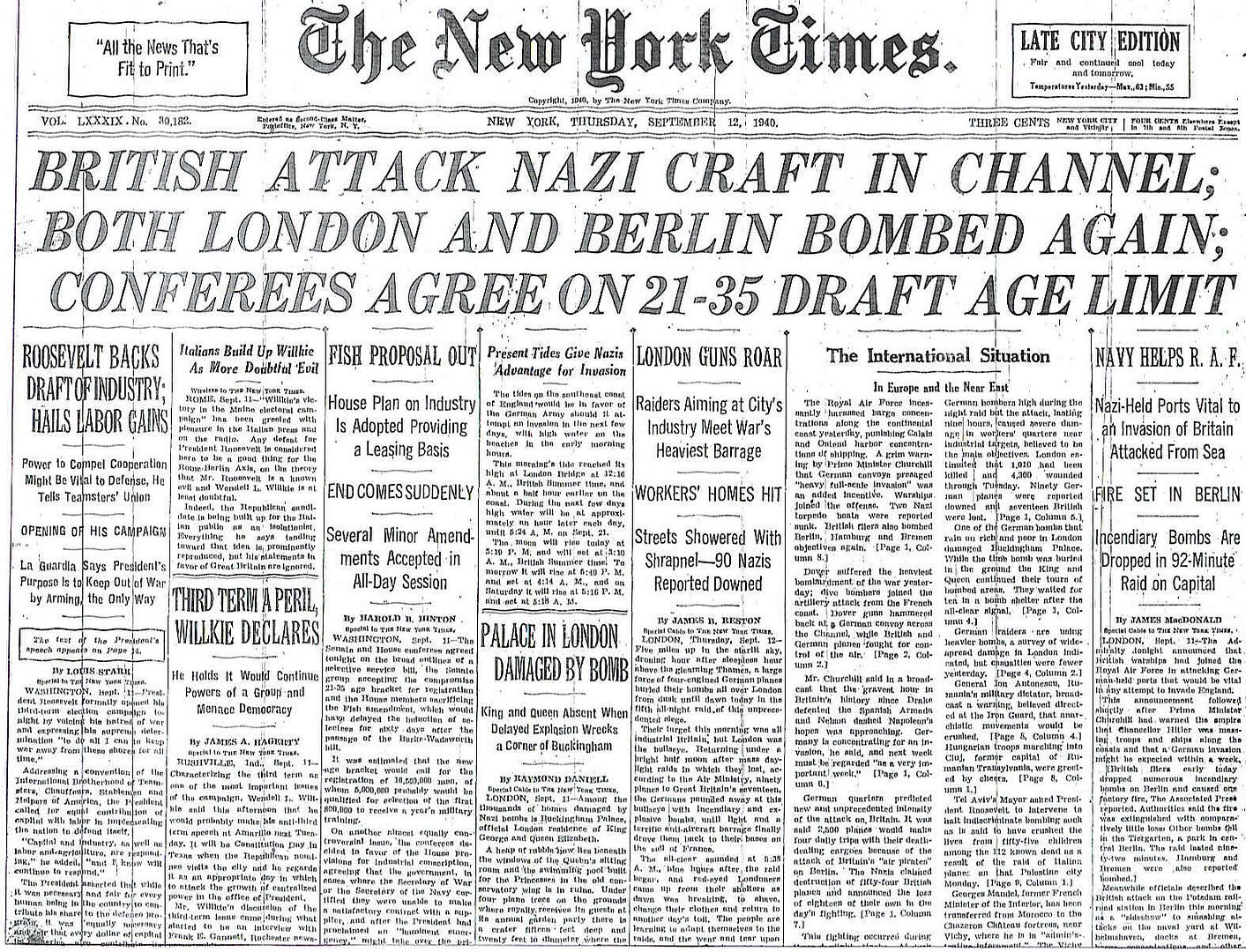
Posted on 09/12/2010 6:13:08 AM PDT by Homer_J_Simpson

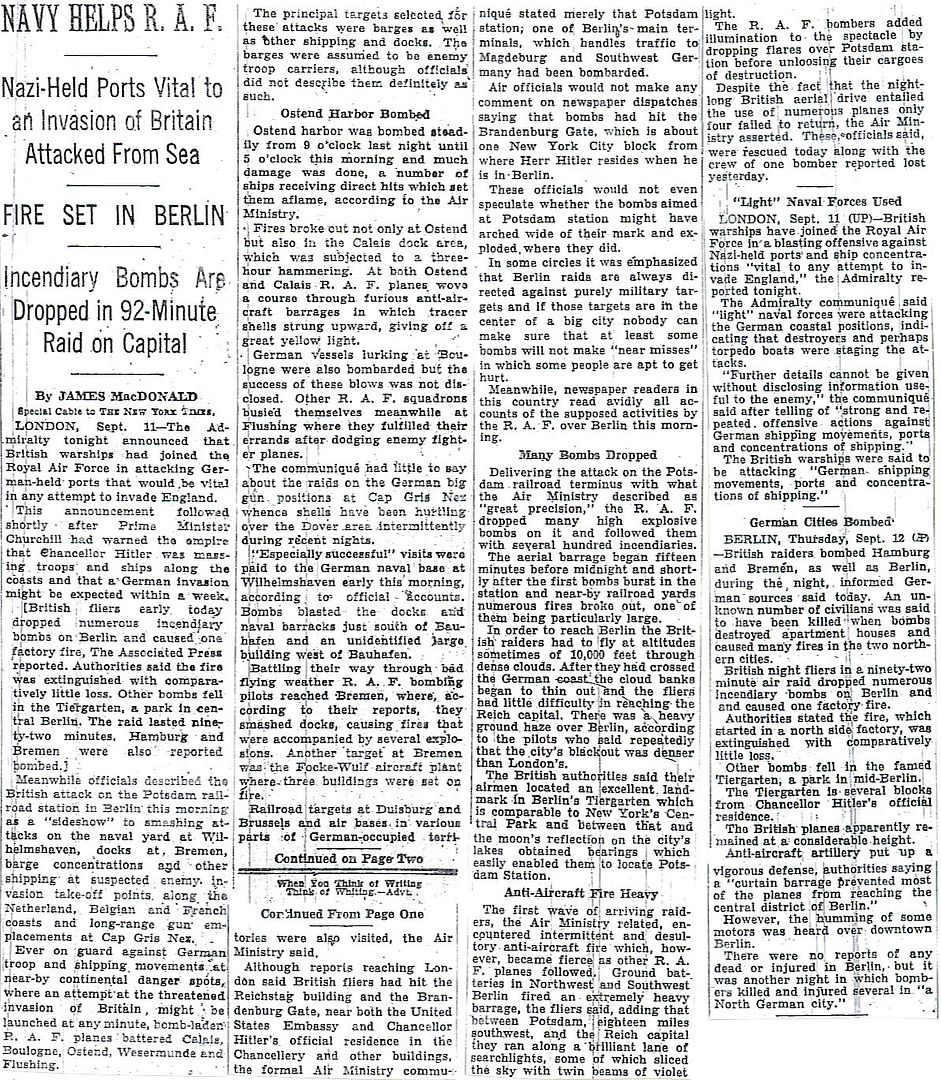
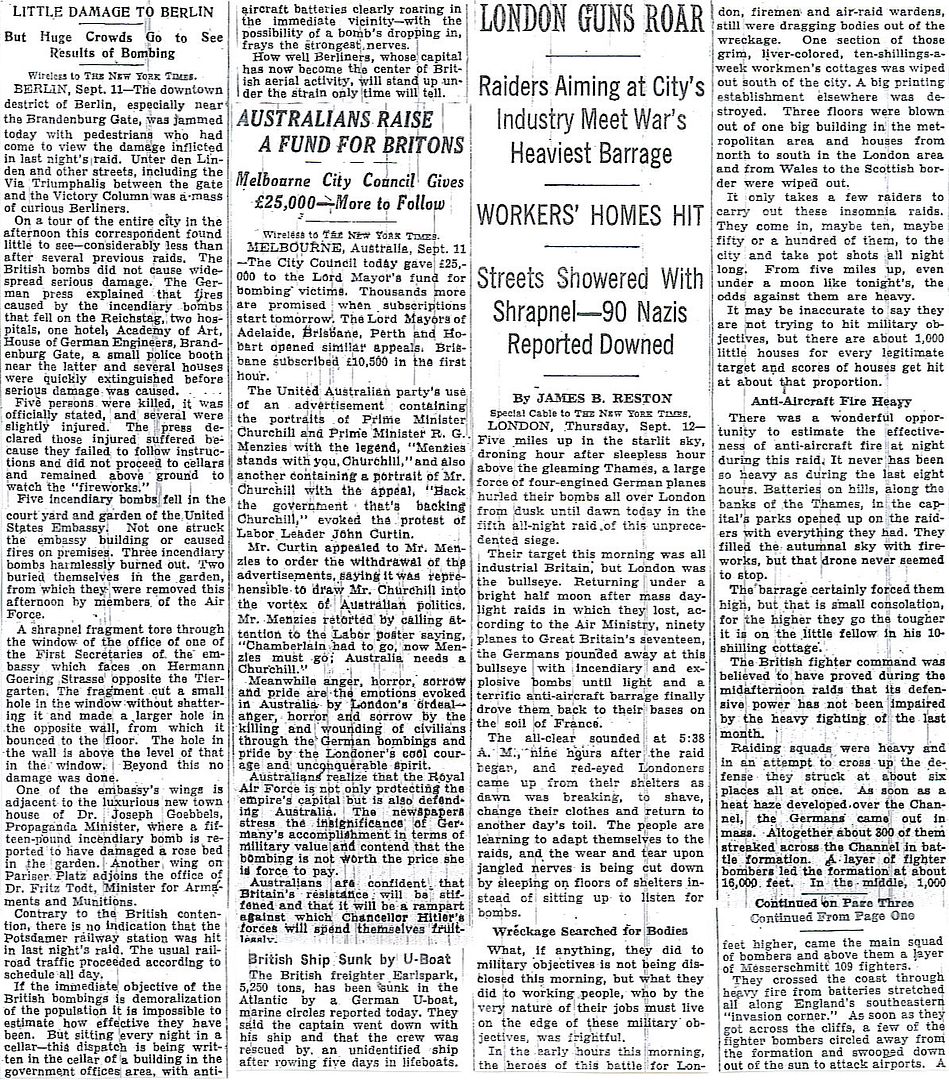
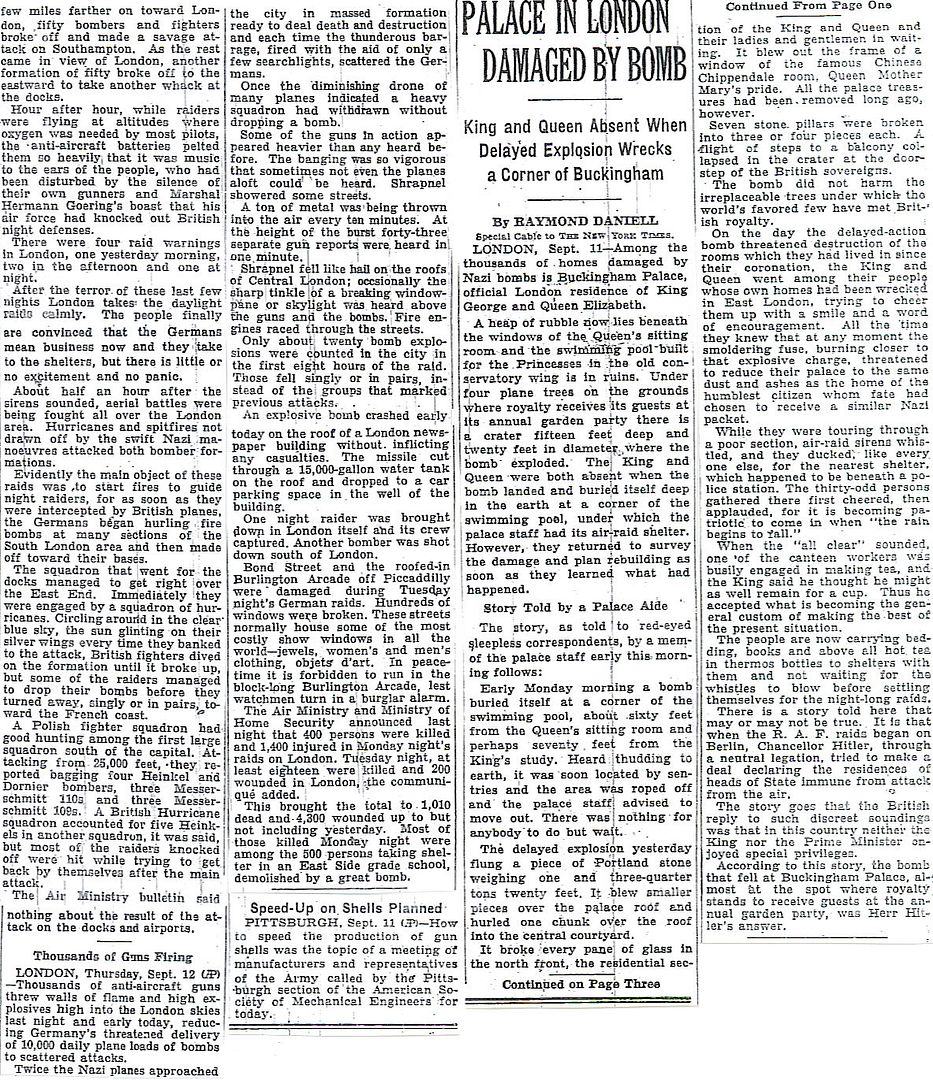
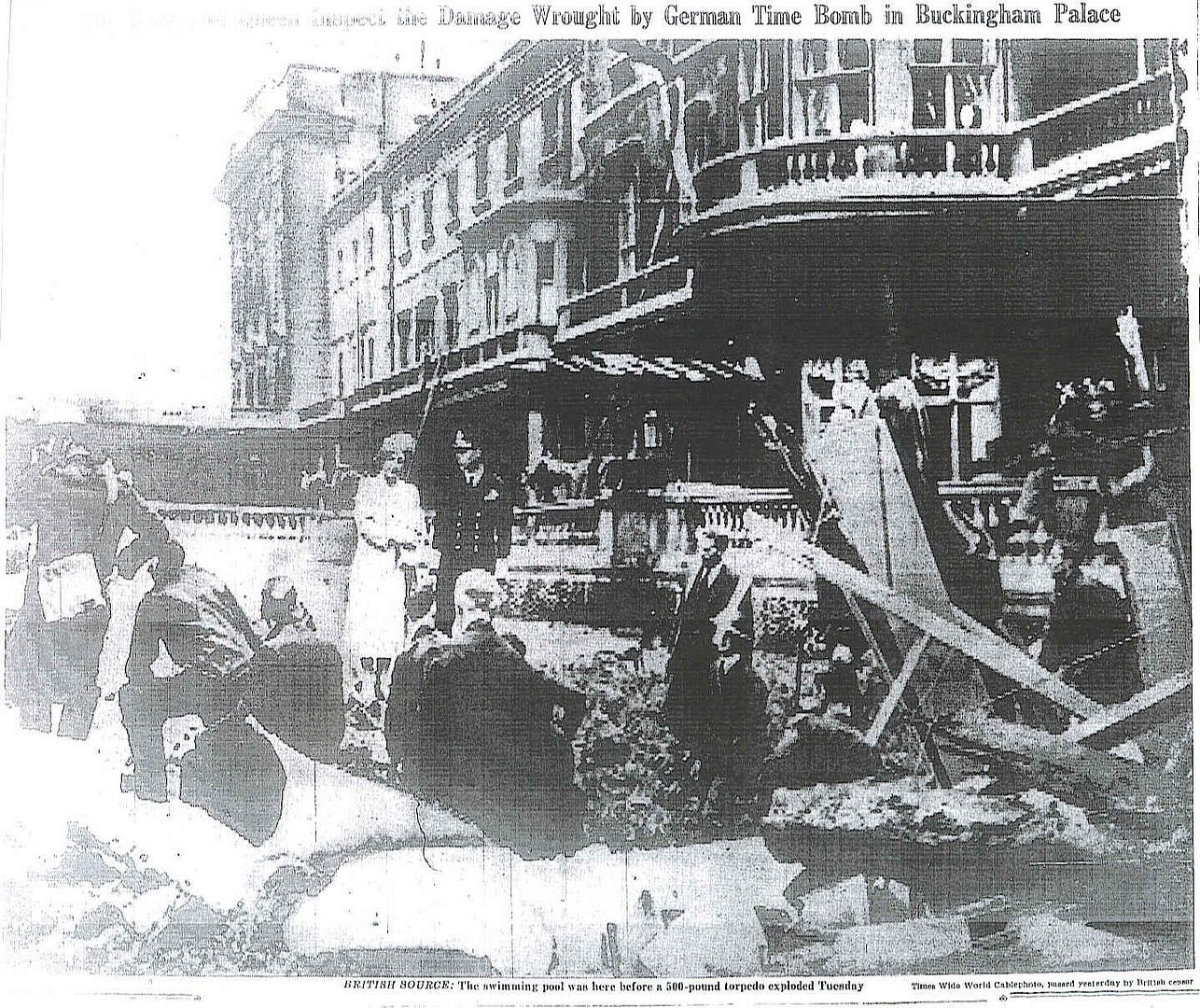
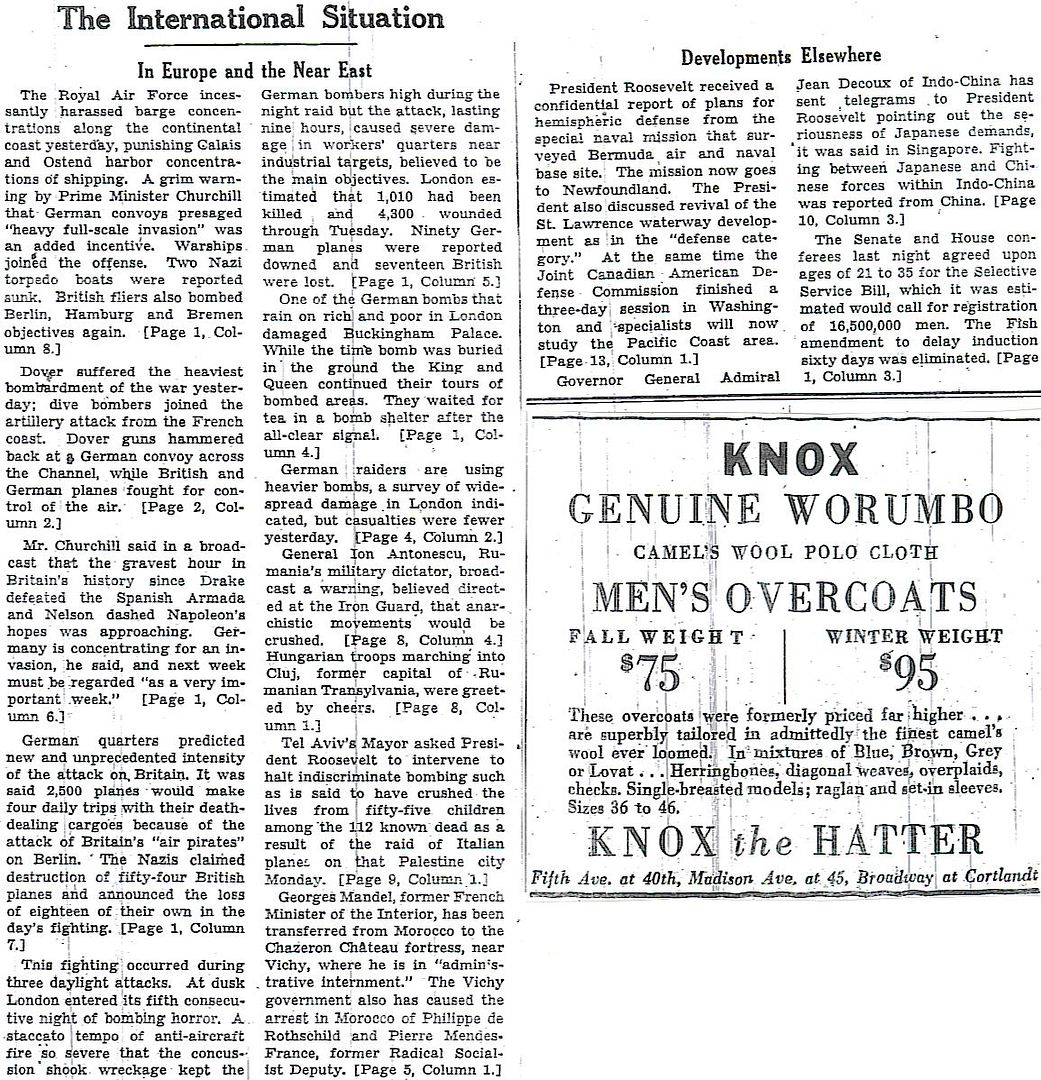
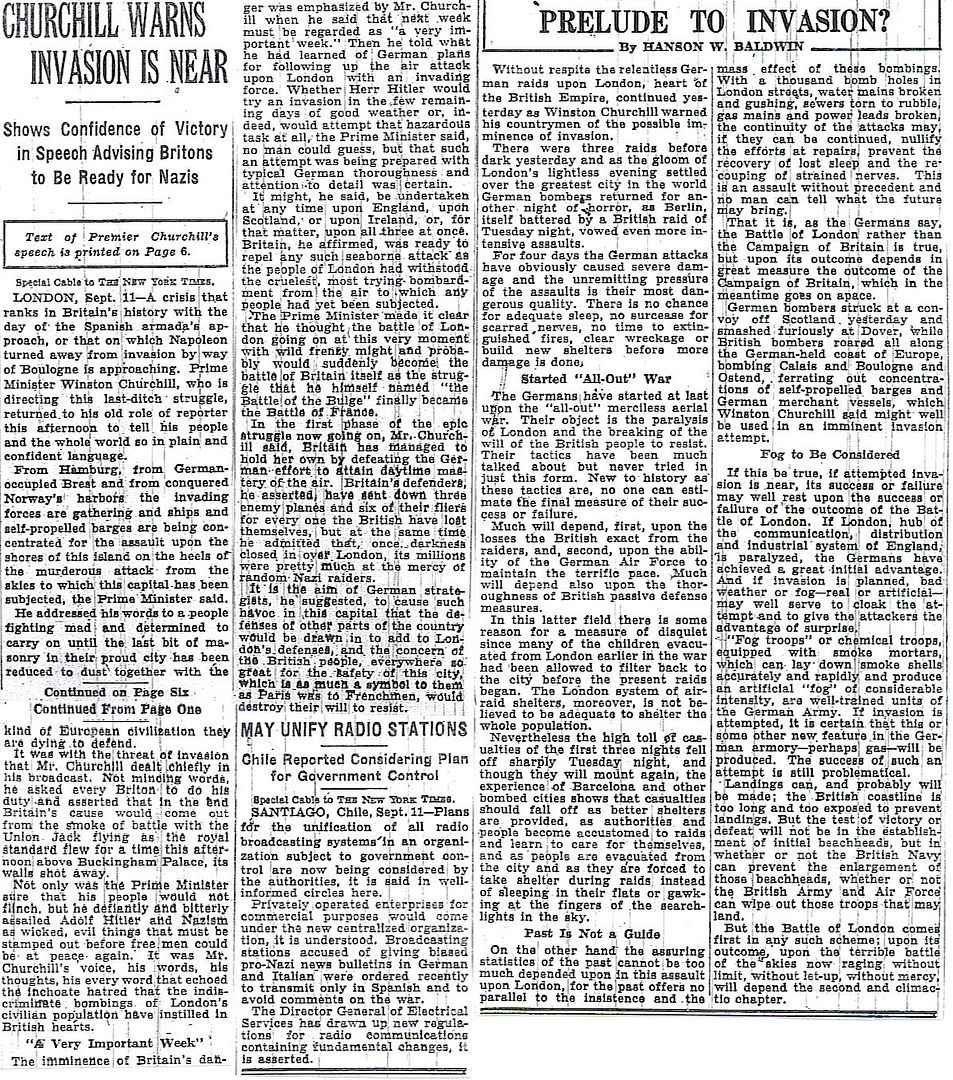
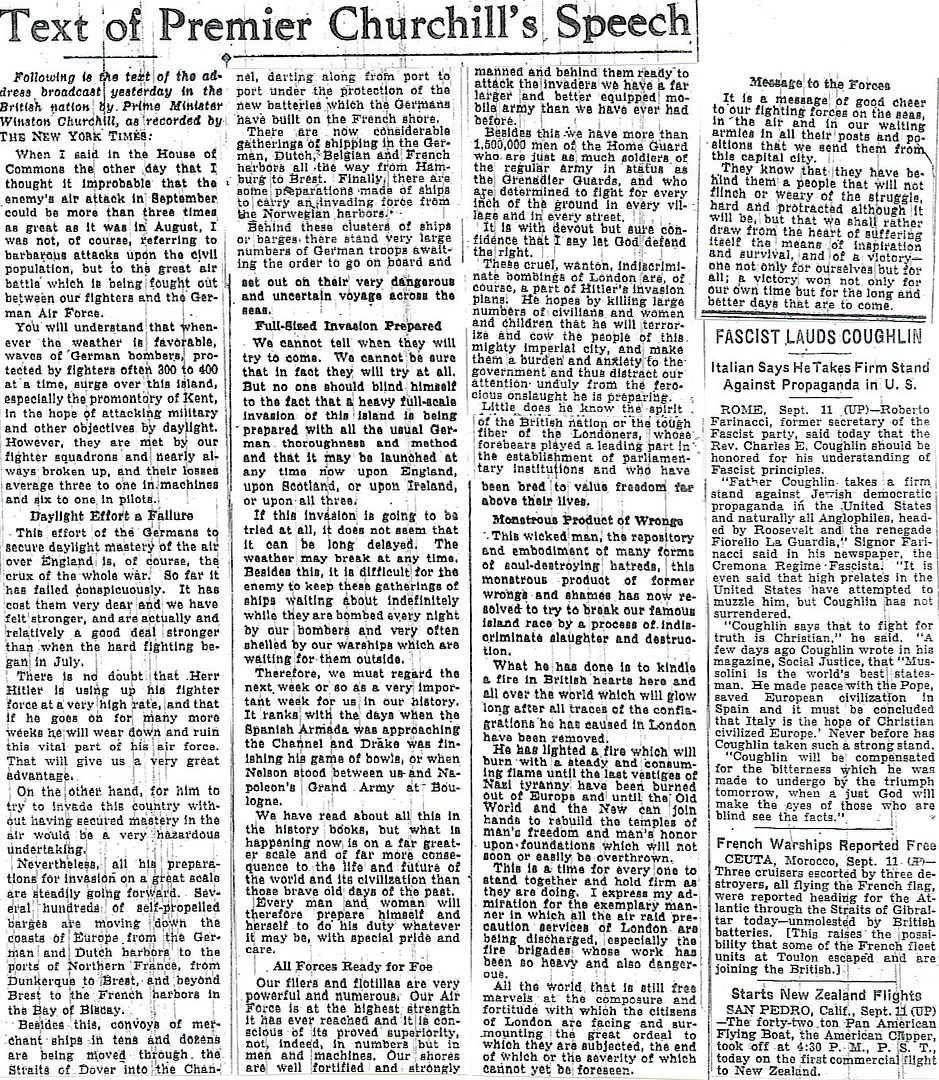
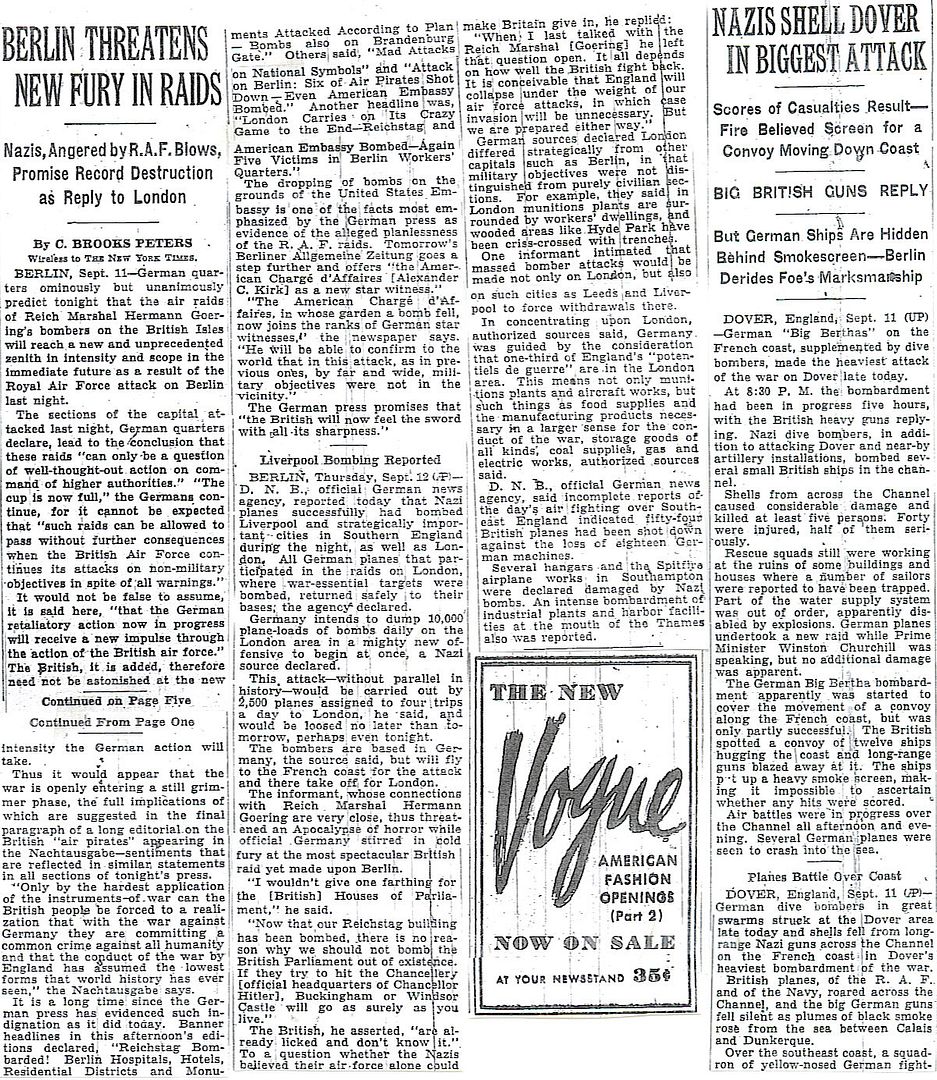
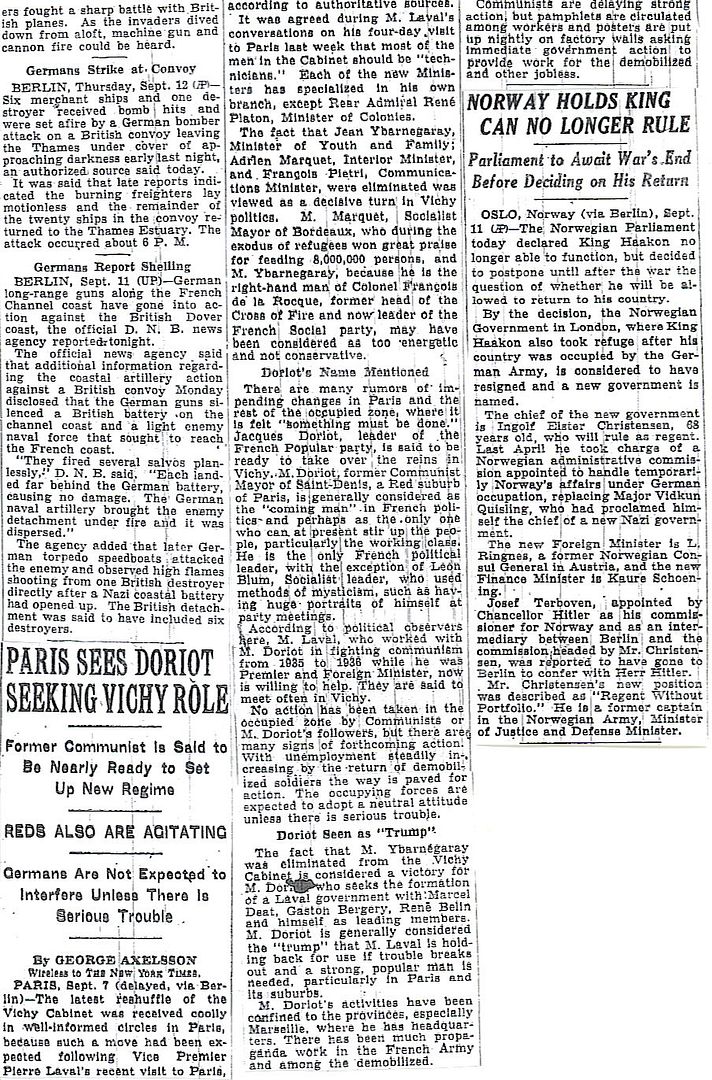
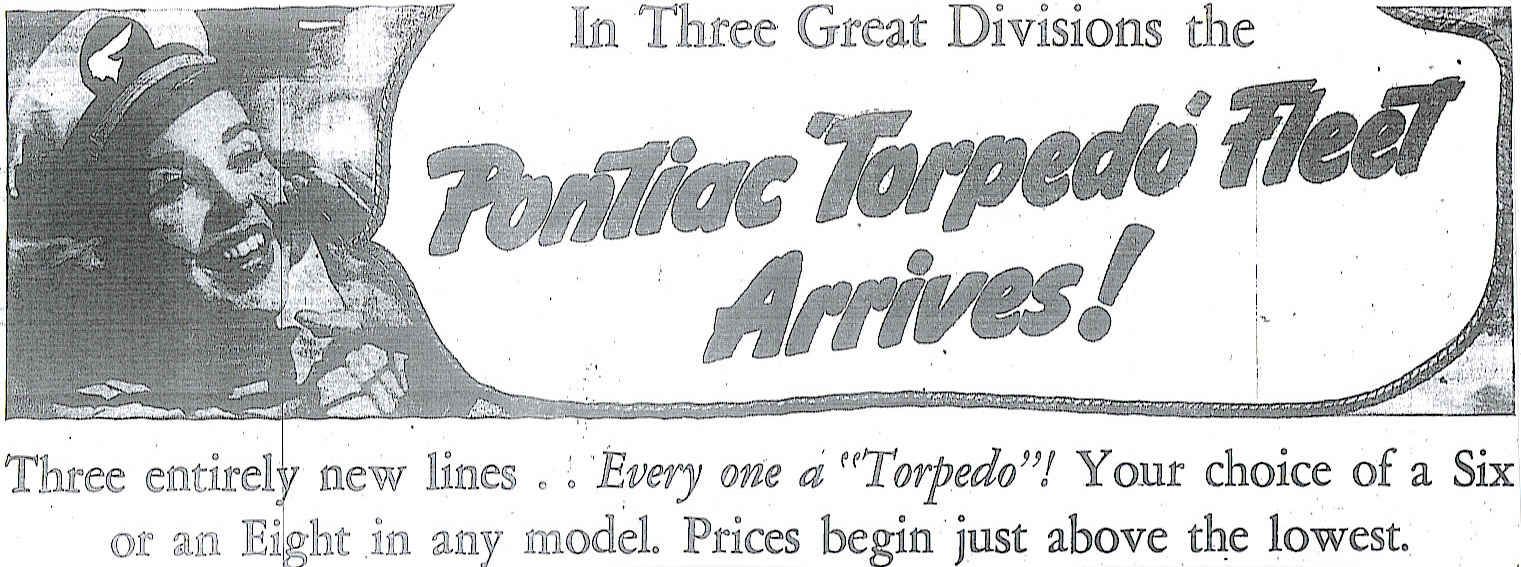
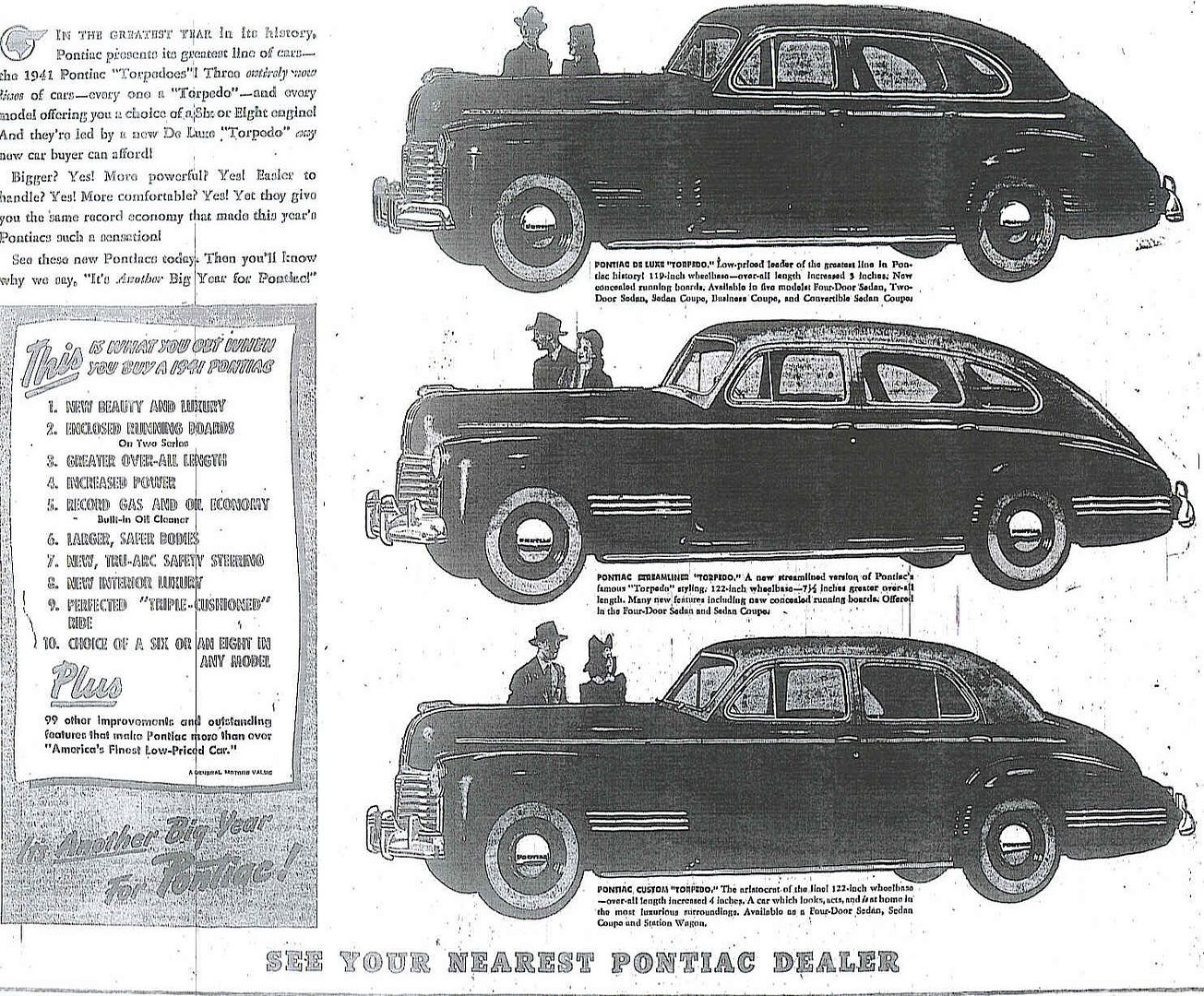
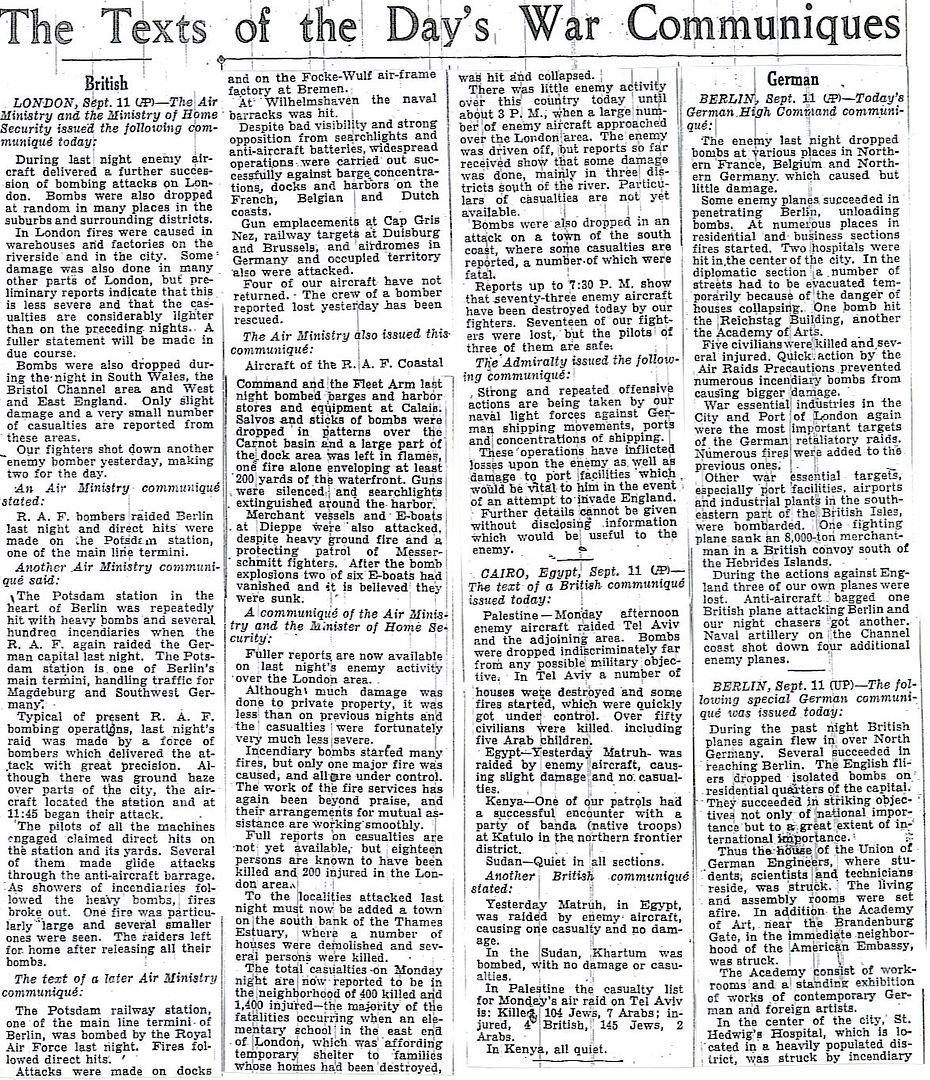
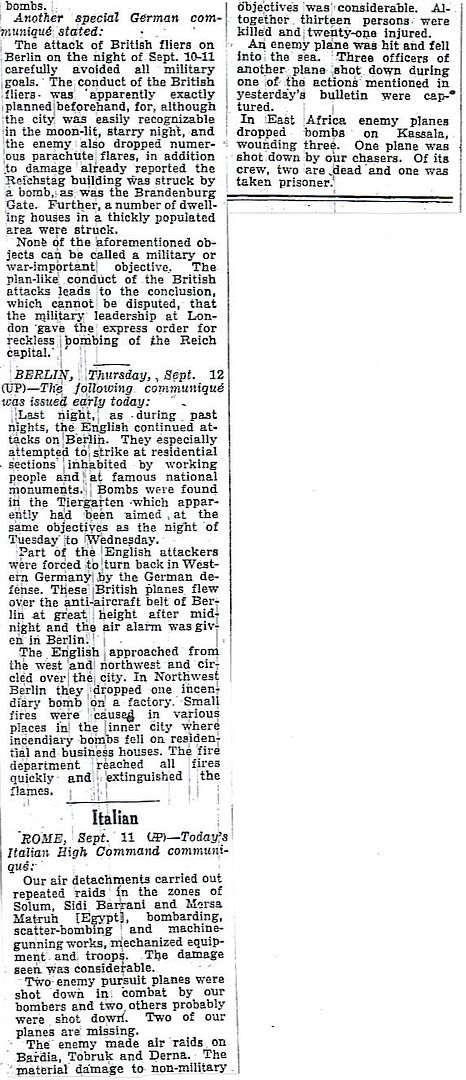

Plus a special guest map from Michael Korda’s, “With Wings Like Eagles,” showing the air defenses of England and Wales, August 1940.
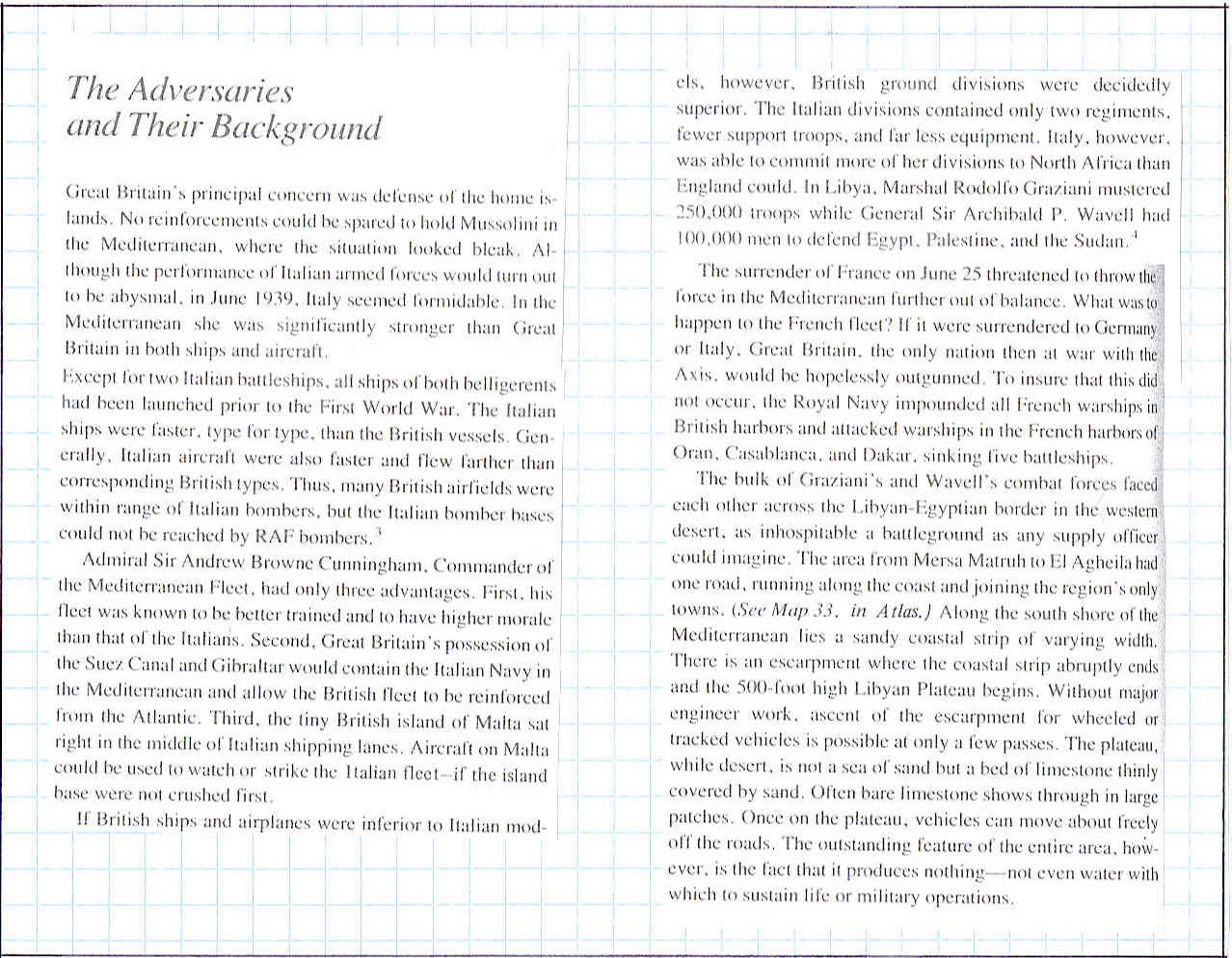
Thomas E. Griess, Series Editor, The Second World War: Europe and the Mediterranean
http://www.onwar.com/chrono/1940/sep40/f12sep40.htm
Prehistoric paintings found in Vichy France
Thursday, September 12, 1940 www.onwar.com
In Vichy France... Five schoolboys discover 10,000-year-old wall paintings of animals and hunters in Lascaux Cave (Dordogne).
Over Germany... British RAF Bomber Command aircraft raid the Hamm marshalling yards for the 60th time during the night (September 12-13).
In Occupied Poland... In Warsaw, a walled ghetto is to be constructed for the estimated 500,000 Jewish inhabitants of the city.
http://homepage.ntlworld.com/andrew.etherington/month/thismonth/12.htm
September 12th, 1940
UNITED KINGDOM:
RAF Bomber Command:
4 Group. 10 OTU Whitley P4997 abandoned by four of crew in bad weather. Flt Sgt L.F. East landed undamaged aircraft near St. Neotts and flew out next day.
Corvette HMS Heliotrope commissioned. (Dave Shirlaw)
Battle of Britain:
Blenheims of 2 Group and Battles of 1 Group attack invasion barges in Ostend harbour, sinking 80.
RAF Fighter Command: Slight enemy activity during the day. German barge concentrations are still growing. At night London, South Wales, the Midlands and Merseyside are raided.
Around Harrogate’s Majestic Hotel HEs exploded injuring 15 people during an attack on an area where the Ministry of Aircraft Production has offices. GWR main line services to Reading are interrupted but another attack fails to hit the Northern Aluminium’s Banbury factory.
In late afternoon Tunbridge Wells is raided, incendiaries causing house fires and destroying the ambulance station. Seven HEs fell at Hornchurch, damaging the emergency operations room and hitting nearby dwellings.
At night London has a seven-hour raid with about 120 bombers operating, a FW200 attacked a ship off the Isle of Man and KG54 mounted a small raid on Rugby. Liverpool was bombed but little damage was caused, but more seriously a lone low-flying raider bombed North Station Blackpool killing a mother of two young boys.
Losses: Luftwaffe, 4; RAF, 0.
London: Spr George Cameron Wylie (b. 1908), Royal Engineers located and removed a bomb from deep under the pavement in front of St Paul’s Cathedral; his superior, Lt Robert Davies (1900-75) drove the bomb away and defused it. (George Cross for both men)
IRISH SEA: A Luftwaffe FW200 attacked a ship off the Isle of Man. (Dave Shirlaw)
FRANCE: Four teenagers follow their dog when it disappears down a hole near Montignac, France, and discover 17,000-year-old drawings now known as the Lascaux Cave Paintings. The 15,000- to 17,000-year-old paintings, consisting mostly of animal representations, are among the finest examples of art from the Upper Palaeolithic period. The Lascaux grotto consists of a main cavern 66 feet (20.12 meters) wide and 16 feet (4.87 meters) high. The walls of the cavern are decorated with some 600 painted and drawn animals and symbols and nearly 1,500 engravings. The pictures depict in excellent detail numerous types of animals, including horses, red deer, stags, bovines, felines, and what appear to be mythical creatures. There is only one human figure depicted in the cave: a bird-headed man. Archaeologists believe that the cave was used over a long period of time as a center for hunting and religious rites. (Jack McKillop)
GERMANY: U-153 and U-407 laid down. (Dave Shirlaw)
FINLAND: Helsinki: Finland signs an agreement giving German troops transit rights to Norway.
EGYPT: Italian forces begin an offensive into Egypt. (Jack McKillop)
CANADA: Corvette HMS Bittersweet launched Lauzon, Province of Quebec. (Dave Shirlaw)
U.S.A.: An explosion at the Hercules Powder Co. in Kenvil, New Jersey, kills 49 and injures 200. (Jack McKillop)
http://worldwar2daybyday.blogspot.com/
Day 378 September 12, 1940
Battle of Britain Day 65. Cloudy weather restricts flying to a minimum. Only German reconnaissance flights take place during the day and 50 bombers attack London overnight (compared to about 300 on previous nights). 2 German bombers are shot down and Wing Commander J.S. Dewar (airfield commander at Exeter) is lost on a pleasure flight to Tangmere in his Hurricane. A delayed action high-explosive bomb hits St. Paul’s Cathedral but does not explode and is buried 30 feet into the ground. Royal Engineers Lieutenant R. Davies and Sapper J. Wylie defuse the bomb and are awarded the George Cross, becoming the first military personnel to receive this medal for “bravery not in the face of the enemy”. St. Paul’s Cathedral will become a symbol of London’s resilience during the Blitz. http://en.wikipedia.org/wiki/St_Paul%27s_Cathedral#Post-Wren_history
Vichy French cruisers depart Casablanca at 4 AM, leaving behind their destroyer escorts. 3 British destroyers join HMS Renown and 3 other destroyers off Casablanca, searching for the French cruisers which are now well on their way South, steaming for Dakar at full speed.
North Africa. Italian 10th Army continues to make slow progress towards the Libyan border with Egypt to begin their invasion. British light covering forces fall back slowly fighting delaying actions.
In the Indian Ocean 330 miles East of Madagascar, German armed merchant cruiser Pinguin stops British steamer Benavon with a shot across the bows. Benavon tries to escape and returns fire with her 4 inch gun but the inexperienced crew does not fit the shells with fuse caps (1 shell hits Pinguin, lodging next to the magazine containing 300 high-explosive mines; a lethal hit if it had exploded). Pinguin shells Benavon into submission (24 killed, 25 crew taken prisoner).
http://www.bismarck-class.dk/hilfskreuzer/pinguin.html
Date: 12th September 1940

Enemy action by day
There was a marked increase in the number of hostile reconnaissances especially in the South-eastern and Southern areas, otherwise enemy activity was on a much reduced scale. Our fighters destroyed one enemy aircraft plus three damaged. Our Casualties nil.
East
One reconnaissance aircraft reported shipping off Spurn Head, while another over the Humber area was intercepted and damaged by No 151 Squadron.
One enemy aircraft reconnoitred Harrogate, Manchester and Liverpool and attacked a target at Harrogate.
In the afternoon, an aircraft was reported off Yarmouth and in the Wash but attempts to intercept were unsuccessful.
South East
In the morning, several reconnaissances were plotted in the Estuary and over the Coast near Dover.
Early in the afternoon, three aircraft crossed the Coast near Dover and reconnoitred South London aerodromes.
From 1500 to 1700 hours, reconnaissance aircraft were reported in the Thames Estuary and six small raids approached South London from the Estuary, Beachy Head and Dungeness. Targets near Beckenham were attacked.
South and West
In the morning, there was a noticeable increase in the number of reconnaissance aircraft in the Channel between Start Point and Dungeness. One raid penetrated inland and attacked targets near Reading and Banbury and one Ju88 which was returning from the Aldershot area, was intercepted and claimed as damaged by No 213 Squadron.
A merchant ship was attacked South of the Isle of Man.
In the afternoon, reconnaissance aircraft flew over the Southampton area, Beachy Head and Swanage. One Do215 was destroyed by No 605 Squadron South of Cap Gris Nez and No 603 Squadron damaged one Do17 over Beachy Head.
One aircraft crossed over Bournemouth and flew on to Birmingham and Liverpool, returning via Birmingham and Shoreham. Another aircraft reconnoitred the Salisbury Plain area.
By night
Night activity was also on a much reduced scale compared with recent nights.
Hostile raids which were mostly plotted as single aircraft, originated from the Channel Islands, Cherbourg and Dieppe areas. Some raids crossed the Coast between Portland and Plymouth and penetrated to South Wales, West Midlands and Liverpool areas. Others crossed the Coast between Selsey Bill and Dungeness and flew up through Sussex and Kent to the London area.
The greater number of raids left the French Coast between 2100 and 2200 hours, after which there was a gradual decrease in activity until about 0330 hours when raids ceased to approach this Country. All raids had finally withdrawn by 0415 hours.
A series of raids flying from Dieppe to London appeared for the most part to use identical tracks and several were plotted as turning at Whitehall whence they flew back on reciprocal tracks.
One enemy aircraft is reported shot down by AA guns in North London, another enemy casualty is claims by the Balloon Barrage at Newport (Monmouthshire) and a third enemy aircraft is reported to have been badly damaged by AA guns in the West Country and was last seen flying very low over the sea.

________________________________________
Statistics
Fighter Command Serviceable Aircraft as at 0900 hours, 12th September 1940
Casualties:
| Enemy Losses | ||
| By Fighters | ||
| Destroyed | Probable | Damaged |
| 1 Do215 | ||
| 1 Ju88 | ||
| 1 Do17 | ||
| 1 Do17 or Ju88 | ||
| 1 | Nil | 3 |
| By Anit-Aircraft | ||
| 1 E/A | 1 E/A | |
| 1 | 0 | 1 |
| By Balloons | ||
| 1 E/A | ||
| 1 | 0 | 0 |
Patrols:
Balloons:
Aerodromes:
Organisation:
Home Security Reports
"We cannot tell when they will try to come. We cannot be sure that in fact they will try at all. But no one should blind himself to the fact that a heavy full-scale invasion of this island is being prepared with all the usual German thoroughness and method and that it may be launched at any time now upon England, upon Scotland, or upon Ireland, or upon all three."If this invasion is going to be tried at all, it does not seem that it can be long delayed. The weather may break at any time. Besides this, it is difficult for the enemy to keep these gatherings of ships waiting about indefinitely while they are bombed every night by our bombers and very often shelled by our warships which are waiting for them outside.
"Therefore, we must regard the next week or so as a very important week for us in our history. It ranks with the days when the Spanish Armada was approaching the Channel and Drake was finishing his game of bowls, or when Nelson stood between us and Napoleon's Grand Army at Boulogne.
"We have read about all this in the history books, but what is happening now is on a far greater scale and of far more consequence to the life and future of the world and its civilization that those brave old days of the past.
"Every man and woman with therefore prepare himself and herself to do his duty whatever it may be, with special pride and care."
Disclaimer: Opinions posted on Free Republic are those of the individual posters and do not necessarily represent the opinion of Free Republic or its management. All materials posted herein are protected by copyright law and the exemption for fair use of copyrighted works.